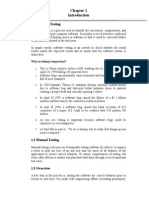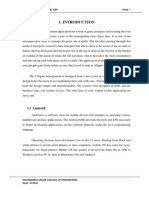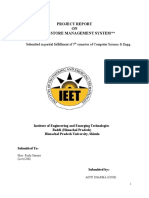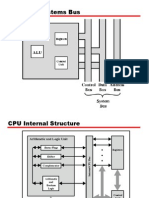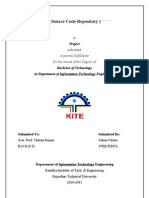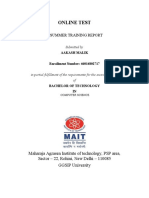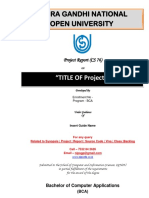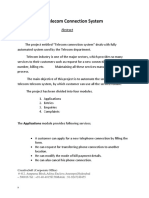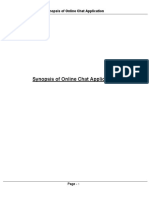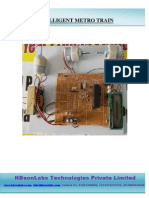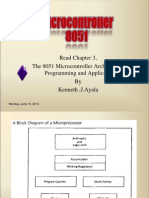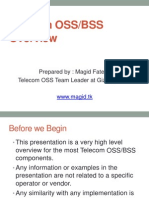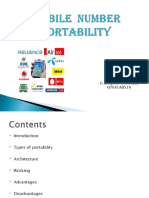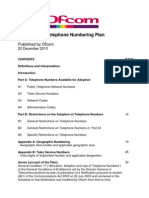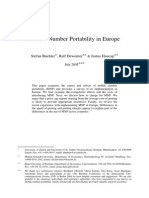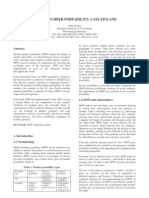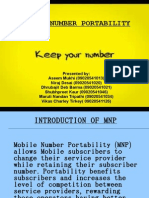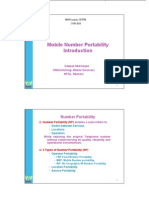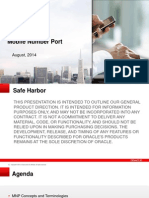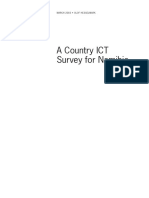0 ratings0% found this document useful (0 votes)
613 viewsMNP Report
MNP Report
Uploaded by
Jithu TvmThe document discusses mobile number portability (MNP) and provides context about its implementation. MNP allows customers to retain their phone numbers when switching mobile network operators. It facilitates competition and consumer choice. For fixed networks, number portability was introduced as networks expanded coverage. MNP is important for new mobile entrants to gain market share. The introduction of MNP globally did not typically lead to large subscriber shifts between operators initially.
Copyright:
© All Rights Reserved
Available Formats
Download as PDF, TXT or read online from Scribd
MNP Report
MNP Report
Uploaded by
Jithu Tvm0 ratings0% found this document useful (0 votes)
613 views31 pagesThe document discusses mobile number portability (MNP) and provides context about its implementation. MNP allows customers to retain their phone numbers when switching mobile network operators. It facilitates competition and consumer choice. For fixed networks, number portability was introduced as networks expanded coverage. MNP is important for new mobile entrants to gain market share. The introduction of MNP globally did not typically lead to large subscriber shifts between operators initially.
Original Description:
MOBILE NUMBER PORTABILITY SEMINAR REPORT
Original Title
MNP REPORT
Copyright
© © All Rights Reserved
Available Formats
PDF, TXT or read online from Scribd
Share this document
Did you find this document useful?
Is this content inappropriate?
The document discusses mobile number portability (MNP) and provides context about its implementation. MNP allows customers to retain their phone numbers when switching mobile network operators. It facilitates competition and consumer choice. For fixed networks, number portability was introduced as networks expanded coverage. MNP is important for new mobile entrants to gain market share. The introduction of MNP globally did not typically lead to large subscriber shifts between operators initially.
Copyright:
© All Rights Reserved
Available Formats
Download as PDF, TXT or read online from Scribd
Download as pdf or txt
0 ratings0% found this document useful (0 votes)
613 views31 pagesMNP Report
MNP Report
Uploaded by
Jithu TvmThe document discusses mobile number portability (MNP) and provides context about its implementation. MNP allows customers to retain their phone numbers when switching mobile network operators. It facilitates competition and consumer choice. For fixed networks, number portability was introduced as networks expanded coverage. MNP is important for new mobile entrants to gain market share. The introduction of MNP globally did not typically lead to large subscriber shifts between operators initially.
Copyright:
© All Rights Reserved
Available Formats
Download as PDF, TXT or read online from Scribd
Download as pdf or txt
You are on page 1of 31
Seminar report 2010 1
Dept. of Electronics and Communication
INTRODUCTION
Mobile Number Portability (MNP) is the ability of customers to retain their telephone
numbers while changing to a different Mobile Network Operator (MNO).It has become
a feature of regulation, considered necessary to reduce switching costs, to facilitate
consumer choice and to ensure effective competition on retail markets.
For fixed networks, number portability was introduced as part of the so-called ladder
of investment. Operators gradually built their networks from the international gateway
first to major switching centers and finally reaching local exchanges in order to
provide a full range of services for business and residential customers. The ladder was
supported by a number of regulatory measured including carrier selection, carrier pre-
selection and NP. For mobile markets it is less likely that number portability is being
introduced to deal with a monopoly provider, more commonly it involves two well
established players and a third and perhaps a fourth smaller operator(s).MNP is
considered very important for new entrants, if they are to obtain a significant market
share, especially where a large proportion of potential customers already has one or
more mobile numbers. In developing countries the absolute number of customers
already possessing a phone and a number may be less important than the extent to
which existing operators have locked in the high value customers and especially
subscribers.
Once consumers and businesses have access to cheap, timely and effective MNP, they
are in a significantly stronger position to negotiate deals from their existing operator or
with a rival. The threat of competition is often sufficient.MNP does not cause churn,
rather it frees customers to express their latent dissatisfaction with prices and quality of
service. It has been argued that MNP can cause consumers to be unaware of the
additional charges they incur for calling different networks and thus reduces the
potential benefits. Indeed, MNOs may have increased their termination rates in order to
exploit this, with potentially negative effects for mobile customers.
It is a very important concept that should be implemented n India where total number
of mobile subscribers cross 45 crore mark at the end of August 2009.number
Seminar report 2010 2
Dept. of Electronics and Communication
portability is also likely to help new entrants into the Indian mobile-services market,
such as the Indian joint ventures of Telenor and Etisalat. The move to introduce the
MNP comes as the countries mobile subscriber base is expanding fast, sometimes
having an impact on network quality. Presently MNP already exists in many
developing and developed countries across the world.
The introduction of MNP in other countries did not lead to a significant shift by
subscribers from one operator to another ,and in India too there will be an initial churn
up to 20 percent of subscribers, which will taper off. Usually customers do more likely
to shift if new operator will introduce network services or if another operator
introduces an aggressive tariff plan.
Seminar report 2010 3
Dept. of Electronics and Communication
HOW CELL PHONE WORKS
THE CELLULAR APPROACH
In a typical analog cell-phone system in the United States, the cell-phone
carrier receives about 800 frequencies to use across the city. The carrier chops up the
city into cells. Each cell is typically sized at about 10 square miles (26 square
kilometers). Cells are normally thought of as hexagons on a big hexagonal grid, like
this:
Because cell phones and base stations use low-power transmitters, the same
frequencies can be reused in non-adjacent cells. Thetwo purple cells can reuse the
same frequencies.
Each cell has a base station that consists of a tower and a small building containing
the radio equipment.A single cell in an analog cell-phone system uses one-seventh of
the available duplex voice channels. That is, each cell (of the seven on a hexagonal
grid) is using one-seventh of the available channels so it has a unique set of
frequencies and there are no collisions:
A cell-phone carrier typically gets 832 radio frequencies to use in a city.
Seminar report 2010 4
Dept. of Electronics and Communication
Each cell phone uses two frequencies per call -- a duplex channel -- so there are
typically 395 voice channels per carrier. (The other 42 frequencies are used for
control channels )
Therefore, each cell has about 56 voice channels available. In other words, in any
cell, 56 people can be talking on their cell phone at one time. Analog cellular systems
are considered
first-generation mobile technology, or 1G. With digital transmission methods (2G), the
number of available channels increases. For example, a TDMA-based digital system
(more on TDMA later) can carry three times as many calls as an analog system, so
each cell has about 168 channels available. Cell phones have low-power transmitters
in them. Many cell phones have two signal strengths: 0.6 watts and 3 watts (for
comparison, most CB radios transmit at 4 watts). The base station is also transmitting
at low power. Low-power transmitters have two advantages:
The transmissions of a base station and the phones within its cell do not make
it very far outside that cell. Therefore, in the figure above, both of the purple
cells can reuse the same 56 frequencies. The same frequencies can be reused
extensively across the city.
The power consumption of the cell phone, which is normally battery-operated,
is relatively low. Low power means small batteries, and this is what has made
handheld cellular phones possible.
The cellular approach requires a large number of base stations in a city of any size. A
typical large city can have hundreds of towers. But because so many people are using
cell phones, costs remain low per user. Each carrier in each city also runs one central
office called the Mobile Telephone Switching Office (MTSO). This office handles all
of the phone connections to the normal land-based phone system, and controls all of
the base stations in the region.
CELL PHONE CODES
All cell phones have special codes associated with them. These codes are used
to identify the phone, the phone's owner and the service provider.Let's say you have a
cell phone, you turn it on and someone tries to call you. Here is what happens to the
call:
Seminar report 2010 5
Dept. of Electronics and Communication
When you first power up the phone, it listens for an SID on the control
channel. The control channel is a special frequency that the phone and base
station use to talk to one another about things like call set-up and channel
changing. If the phone cannot find any control channels to listen to, it knows it
is out of range and displays a "no service" message.
When it receives the SID, the phone compares it to the SID programmed into
the phone. If the SIDs match, the phone knows that the cell it is communicating
with is part of its home system.
Along with the SID, the phone also transmits a registration request, and the
MTSO keeps track of your phone's location in a database -- this way, the
MTSO knows which cell you are in when it wants to ring your phone.
The MTSO gets the call, and it tries to find you. It looks in its database to see
which cell you are in.
The MTSO picks a frequency pair that your phone will use in that cell to take
the call.
The MTSO communicates with your phone over the control channel to tell it
which frequencies to use, and once your phone and the tower switch on those
frequencies, the call is connected. Now, you are talking by two-way radio to a
friend.
As you move toward the edge of your cell, your cell's base station notes that
your signal strength is diminishing. Meanwhile, the base station in the cell you
are moving toward (which is listening and measuring signal strength on all
frequencies, not just its own one-seventh) sees your phone's signal strength
increasing. The two base stations coordinate with each other through the
MTSO, and at some point, your phone gets a signal on a control channel telling
it to change frequencies. This hand off switches your phone to the new cell.
Seminar report 2010 6
Dept. of Electronics and Communication
As you travel, the signal is passed from cell to cell.
Let's say you're on the phone and you move from one cell to another -- but the
cell you move into is covered by another service provider, not yours. Instead of
dropping the call, it'll actually be handed off to the other service provider.
If the SID on the control channel does not match the SID programmed into
your phone, then the phone knows it is roaming. The MTSO of the cell that you are
roaming in contacts the MTSO of your home system, which then checks its database to
confirm that the SID of the phone you are using is valid. Your home system verifies
your phone to the local MTSO, which then tracks your phone as you move through its
cells. And the amazing thing is that all of this happens within seconds.
The less amazing thing is that you may be charged insane rates for your
roaming call. On most phones, the word "roam" will come up on your phone's screen
when you leave your provider's coverage area and enter another's. If not, you'd better
study your coverage maps carefully --more than one person has been unpleasantly
surprised by the cost of roaming. Check your service contract carefully to find out how
much you're paying when you roam.
CELL PHONE CODES
Electronic Serial Number (ESN) a unique 32-bit number programmed into
the phone when it is manufactured
Seminar report 2010 7
Dept. of Electronics and Communication
Mobile Identification Number (MIN) a 10-digit number derived from your
phone's number
System Identification Code (SID) - a unique 5-digit number that is assigned to
each carrier by the FCC.
While the ESN is considered a permanent part of the phone, both the MIN and
SID codes are programmed into the phone when you purchase a service plan
and have the phone activated.
CELL-PHONE NETWORK TECHNOLOGIES: 2G
There are three common technologies used by 2G cell-phone networks for
transmitting information .
Frequency division multiple access (FDMA)
Time division multiple access (TDMA)
Code division multiple access (CDMA)
Although these technologies sound very intimidating, you can get a good sense of
how they work just by breaking down the title of each one.The first word tells you
what the access method is. The second word, division, lets you know that it splits calls
based on that access method.
FDMA puts each call on a separate frequency.TDMA assigns each call a certain
portion of time on a designated frequency.CDMA gives a unique code to each call and
spreads it over the available frequencies.The last part of each name is multiple access.
This simply means that more than one user can utilize each cell.
Seminar report 2010 8
Dept. of Electronics and Communication
In FDMA, each phone uses a different frequency
TDMA splits a frequency into time slots.
GSM
TDMA is also used as the access technology for Global System for Mobile
communications (GSM). However,GSM implements TDMA in a somewhat different
and incompatible way from IS-136. Think of GSM and IS-136 as two different
operating systems that work on the same processor, like Windows and Linux both
working on an Intel Pentium III. GSM systems use encryption to make phone calls
more secure. GSM operates in the 900-MHz and 1800-MHz bands in Europe and Asia
Seminar report 2010 9
Dept. of Electronics and Communication
and in the 850-MHz and 1900-MHz (sometimes referred to as 1.9-GHz) band in the
United States. It is used in digital cellular and PCS-based systems. GSM is also the
basis for Integrated Digital Enhanced Network (IDEN), a popular system introduced
by Motorola and used by Nextel.GSM is the international standard in Europe, Australia
and much of Asia and Africa. In covered areas,cell-phone users can buy one phone that
will work anywhere where the standard is supported. To connect to the specific service
providers in these different countries, GSM users simply switch subscriber
identification
module (SIM) cards. SIM cards are small removable disks that slip in and out of GSM
cell phones. They store all the connection data and identification numbers you need to
access a particular wireless service provider.
In CDMA, each phone's data has a unique code.
CELL-PHONE NETWORK TECHNOLOGIES: 3G
3G technology is the latest in mobile communications. 3G stands for "third
generation" -- this makes analog cellular technology generation one and digital/PCS
generation two. 3G technology is intended for the true multimedia cell phone --
typically called smartphones -- and features increased bandwidth and transfer rates to
accommodate Web-based applications and phone-based audio and video files.
Seminar report 2010 10
Dept. of Electronics and Communication
Sony Ericsson V800 3G phone
Of course, none of this would be possible without those soaring towers that
carry cell-phone signals from phone to phone.
Seminar report 2010 11
Dept. of Electronics and Communication
THE VALUE OF NUMBERS
The value associated with a telephone number, fixed or mobile ,arises from the
customer who will receive the calls. It is they who have propagated the numbers to
Customers and suppliers
Colleagues
Family and friends
It is their caller identity that people recognize and use to accept the call or to read
the text message. It is their names in directories, personal or commercial, that allow
people to dial the number. In these ways, customers generate the inbound and the
outbound traffic that creates revenues for the operators.
There is a test case of marketing calls made to randomly generated numbers, which
frequently creates considerable resentment from recipients. So much so that one result
has been the adoption in several countries of opt-in regimes for marketing calls
requiring prior registration.
In some countries operators have used the network code as a marketing tool. By
charging high termination rates and low on-net rates they Endeavour to create an
incentive for groups of customers to be on the same network. By promoting the code
number as part of the brand, they try to strengthen this. Until MTRs are reduced to a
level reflecting the underlying costs, this problem will remain. Nonetheless it is
necessary to recognize that the operators decreate some economic value for their
network code.
There are several specific ranges of numbers for services, notably for toll-free or free
phone. Additionally, there are short codes on mobile networks. These have been
developed into substantial markets, both for customer care and marketing services,
closely related to outsourcing. Much of this traffic is routed over international
networks to distant call centers. Number portability enhances competition in the supply
of toll-free services. Competition between operators drives down the cost and improves
the quality of these services, encouraging companies to use toll-free numbers.
Originally numbering schemes were designed to convey indications of the tariffs that
applied and the costs that would be incurred by a call. However, in many countries the
tariff schemes are now so complex that few people, other than the experts, know the
Seminar report 2010 12
Dept. of Electronics and Communication
real significance of a number. Often callers have misleading perceptions of the costs
that will be incurred.
The value of numbers and the sources of that value are important in reaching any
decisions about public policy, in particular in assigning any value of numbers to
operators, since it is they who have demonstrated such clear opposition to MNP.
Numbers are merely indicators of customers, often in a specific role (parent or
employee) and thus the value belongs to them.
MNP IN THEORY
The need to change number when moving to a different operator creates a switching
cost that reduces consumer welfare. It also has anti-competitive effects, by deterring
market entry and by preventing price reductions, since customers would be less likely
to take advantage of these offers. Additional costs for negotiations and for technical
systems are incurred by the introduction of MNP, which must be met from one source
or another, reducing potential consumer welfare.
Aoki and Small, in 1999, made an initial analysis of the economics of number
portability on fixed networks. They argued that in a well developed telephony market,
with high penetration rates, it would be possible for consumers to receive fewer
surpluses following a reduction in the cost of switching between carriers as a result of
the introduction of number portability. They also noted the need for empirical studies
including a demand side analysis of the consumer valuation of portability and
information on the costs of implementing portability and the difference that this would
make to current levels of switching costs. A property right approach to fixed number
portability was explored by Gans, King and Woodbridge. They argued that NRAs,
rather than viewing number portability as a traditional cost allocation problem with a
technological choice, should give consumers ownership of phone numbers with a right
to number portability, encouraging them to search for socially efficient outcomes.
Their proposed solution freed the regulator from making several difficult assessments
and had the political attraction that consumers are main beneficiaries of the flow of
social rents, while it would retain the incentives for maximum network competition.
Lyons has argued that MNP has caused a significant increase in churn rates and also in
average retail prices. However, MNP cannot cause churn, it merely frees customers to
express their dissatisfaction by changing to another operator, at worst it has a catalytic
or enabling effect.
Seminar report 2010 13
Dept. of Electronics and Communication
In India, Department of Telecommunications (DoT) has selected Syniverse
Technologies and Telcordia Technologies to implement mobile number portability
(MNP) services in the country.
Syniverse is a business and technology solution for the global telecommunications
industry, headquartered in Tampa, Florida, USA; the company was awarded a letter of
intent to provide Indias telecommunications operators with number portability
clearing house and centralized database solutions for the next 10 years. The companys
solutions make it possible for disparate technologies and standards to interoperate, so
operators in the mobile industry can provide their subscribers with access to voice
calls, data and other services as users move across networks around the world.
Syniverses core service areas include messaging, roaming, network and database, and
business intelligence solutions.
Telcordia on other hand is the worlds leading provider of MNP services and has
solutions deployed across nine countries, including the US, Canada, Egypt, Greece and
South Africa. As part of the Telcordia Technologies family of companies, Telcordia
Technologies India Private Limited (Telcordia India) provide open, flexible, and
configurable software and services for IP, wireline, mobility and cable networks
helping communications companies transform, manage, and grow their networks.
TYPES OF NUMBER PORTABILITY
1.Wireless number portability: It relates to transferability between wireless
mobile lines only and not between fixed lines and wireless. In most of the country this
type of mobile network portability is existing.
2.Fixed number portability: It allows transfer between both fixed lines and mobile
phone lines. Iceland, Canada and US are the only country in the world that offer this
type of services.
3.Service Provider Number Portability: Subscribers can change the service provider while retaining
the same phone number. It is also called operator portability.
4.Location Number Portability: Subscribers can change their service location while keeping the same
telephone number.
5.Service Portability: Subscribers can change the subscribed services while
retaining the same telephone number. Service portability allows the subscribers to
enjoy the subscribed services in the same way when they roam outside their home
Seminar report 2010 14
Dept. of Electronics and Communication
SERVICE PROVIDER NUMBER PORTABILITY CALL
ROUTING SCHEMES
MNP is now well established technical feature of networks. The Internet
Engineering Task Force (IETF) has defined four flavors of call routing that support
number portability. All of these require an intelligent network, but handles calls in
slightly different ways which affect the costs incurred in handling calls. These schemes
are:
. All Call Query (ACQ)
. Query on Release (QoR)
. Call Dropback
. Onward
To understand the technical aspects and various call routing schemes in detail,
some terms in the context of mobile network and number portability should be known..
Donor Network: It is the network that first assigns a telephone number to a
subscriber.
Recipient Network: It is the network that currently serves the ported number. A
recipient network is a network that a subscribers number is ported to when the
subscriber switches the service provider.
Old Serving Network: The old serving network is the network that previously served
the ported number before the number was ported to the new serving network. Since a
subscriber can switch service provider any number of times, the old SP is not
necessarily the same as the donor network.
Participant: A Participant is a service provider who is not related to the porting
process in any way and still needs the routing information for call routing and various
other activities.
Seminar report 2010 15
Dept. of Electronics and Communication
ALL CALL QUERY (ACQ).
The Originating Network receives a call from the caller and sends a query to a
centrally administered Number Portability Database (NPDB) also called central
database (CDB). Network operators generally keep local copies of the CDB, which is
hosted on either a network element within their network or a third party network
element. The NPDB returns the routing information of the dialed number. The
Originating Network uses the routing information to route the call to the new serving
network
2 1
3
QUERY ON RELEASE (QoR)
The Originating Network receives a call from the caller and routes the call to
the donor network. The donor network releases the call and indicates that the dialed
number has been ported out of that network. The Originating Network sends a query to
its copy of the centrally administered NPDB. The NPDB returns the routing.
information of the dialed number. The Originating Network uses the routing
information to route the call to the new serving network
NP
database
Originating
Network
Recipient Network
Donor Network
Seminar report 2010 16
Dept. of Electronics and Communication
2 1 4 3
. CALL DROP BACK
This scheme is also known as Return to Pivot (RTP). The call steps are as follows..
The Originating Network receives a call from the caller and routes the call to the donor
network. The donor network detects that the dialed directory number has been ported
out of the donor switch and checks with an internal network-specific NPDB.
1
The internal NPDB returns the routing number associated with the dialed directory
number. The donor network releases the call by providing the routing number. The
NP
database
Originating
Network
Recipient Network
Donor Network
5
Originating
Network Recipient Network
Central
NP
database
e
2
3
4
5
Donor Network
Internal
NP
database
Seminar report 2010 17
Dept. of Electronics and Communication
Originating Network uses the routing number to route the call to the new serving
network.
ONWARD ROUTING (OR)
The Originating Network receives a call from the caller and routes the call to the donor
network. The donor network detects that the dialed directory number has been ported
out of the donor switch and checks with an internal network-specific NPDB. The
internal NPDB returns the routing number associated with the dialed directory number.
The donor network uses the routing number to route the call to the new serving
network. This method of routing calls is also known as Call Forwarding
2
3
1 4
COMPARISONS OF THE NUMBER PORTABILITY
SCHEMES
Of the four number portability call routing implementations, the ACQ is the
only implementation that does not involve the donor network when routing the call to a
new serving network. Thus, the ACQ scheme is the most efficient in terms of using the
network resources for routing the call to a ported number.
The OR scheme requires to setup two physical calls - one from the originating
network to the donor network and the other from the donor network to the new serving
network. This increases the usage of network resources and hence is the least efficient
in terms of using the network transmission facilities.
NP
database
Recipient Network
Donor Network
Originating Network
Internal
NP
database
Seminar report 2010 18
Dept. of Electronics and Communication
The QoR and Call Dropback schemes set up calls to the donor network first but
release the call back to the originating network that then initiates a new call to the
Current Serving Network.
In the QoR and Dropback schemes, dedicated signaling circuits are set up between the
originating network and the donor network when the originating network sets up the
call towards the donor network. This complexity increases the signaling between the
networks and hence the cost of the call to a ported number increases.
VERSIONS IN ACQ SCHEME
There are two possible versions of ACQ scheme. In the first one, the
originating network always queries the NPDB when a call is received from the caller
regardless of whether the dialed number belongs to any number range that is portable
or has at least one number ported out. Number range covers a contiguous range of
numbers within that range. Once a number within a particular range has ported away
from the donor network, all numbers in that range are considered potentially ported.
The other version is to check whether the dialed number belongs to any number range
that is portable or has at least one number ported out. If yes, an NPDB query is sent. If
not, no NPDB query is sent. The former performs best when there are many portable
number ranges. The latter performs best when there are not too many portable number
ranges. The latter ACQ scheme is similar to the QoR scheme, except that the QoR
scheme uses call setup and relies on the donor network to indicate number ported out
before initiating the NPDB query.
IMPLEMENTATION
There are two fundamental issues that need to be considered in implementing
number portability in a country..
Number Porting Process: This applies to the policies and processes for porting the
numbers.
Call Routing: This applies to the scheme of routing a call to a ported number.
Seminar report 2010 19
Dept. of Electronics and Communication
NUMBER PORTING PROCESS: PROCEDURE AND
CONSIDERATIONS
Number porting process involves a set of parties, which includes donor (or
current serving SP), recipient (new SP) and many participants (other service providers
not related to the number that is being ported). The basic requirement of the porting
process is that a subscriber needs to initiate a request to the service provider. The
request can be initiated to either of the service providers (current serving SP or the new
SP). This depends on the regulatory policies of the country. There are two approaches
by which the number porting database can be maintained and implemented.. Peer-to-
Peer approach. Centralized approach
Peer-to-Peer approach
In this approach, there is a bilateral agreement between two service providers. The two
service providers agree on their implementation of number portability based on
proprietary interface. With this non-standard approach, there can be multiple
commercial agreements between the service providers, which make it difficult to
manage the terms of each agreement, and track the porting requests. This approach is
very complex, and the complexity is further increased with increasing number of
service providers.
Service provider 2
Service provider 3
Service provider 4
Service provider 5
Service provider 1
Seminar report 2010 20
Dept. of Electronics and Communication
Centralized approach
In this approach, the regulatory authority of the country sets up the guidelines,
policies and processes for number portability. All the service providers in the country
have a shared and well-defined interface with a centralized NP administration center
for processing the porting request of a number. This adheres to a clear set of service
level agreements for each of the steps involved in the process and it is mandatory for
the service providers to follow them.
Any porting request from any of the service providers is sent to the NP
administration center first, to which all the service providers number portability
solutions are integrated with. A request that comes from the new SP to the NP
administration center is sent to the present serving SP for clearance and once this is
done the central NP administration center broadcasts the porting information to all the
service providers in the country. As specified above, the porting request can be
initiated by either of the current serving SP or the new SP (recipient). This is decided
by the regulatory body of the country.
SOAP/CORBA/XML/Q.3
Service provider1 Service provider2 Service
Service provider1 Service provider2 Service provider4
Central number
portability
administration center
and database
Service
Provider
Gateway
Service
Provider
Gateway
Service
Provider
Gateway
Local
NPDB
Local
NPDB
Local
NPDB
Local
NPDB
Local
NPDB
Local
NPDB
Seminar report 2010 21
Dept. of Electronics and Communication
he centralized approach is the most preferred solution and is widely used across the
globe. This is a highly scalable implementation.
CALL ROUTING
All Call Query (ACQ) scheme is the most efficient in terms of using network
resources. The advantages of using ACQ to implement number portability are:. No
dependency on other network for routing the call. Easy billing for calls to the ported
numbers. Call set-up time for calls to ported numbers is minimal. Minimal impact on
signaling. Impact on network complexity is very less
TYPICAL FLOW OF PORTING DATA
The porting request once given by the subscriber to the service provider (new
or current serving SP) is forwarded to the central clearing administrator. The actual
porting process starts from the central clearing administrator.
The administrator clears the number based on the policies and processes agreed
upon by both the service providers (donor and recipient), the number is marked as
ported and the administrator or the central clearing house broadcasts the complete
information to all the service providers in the country or as registered with the central
clearing authority.
SOAP/CORBA/XML/Q.3
Central number portability
administration center and database
Local Service Provider NP
Gateway
HLR
Billing
system
Customer
relationship
management
Other
network
elements
Local
NPDB
Service Provider
Domain
Provisioning to the respective
network element
Seminar report 2010 22
Dept. of Electronics and Communication
FACTORS INFLUENCING THE SUCCESS OF NUMBER
PORTABILITY.
Subscriber Awareness: Subscribers needs to be aware of Number Portability (NP), its
advantages, and how to go about it.
Simplicity: NP success mainly depends on the simplicity of the process. There could
be many rules that the regulator may impose. For example, a number cant be ported in
the first 6 months of the subscription. Such forced conditions hamper the success of
NP.
Speed: Speed is one of the major factors that affect the success of NP. Service level
agreements should be stringent enough to minimize the time taken to port the number
to other network. This increases the level of customer satisfaction
Cost factor: NP success also depends on the cost of porting the number. The lower the
cost, the higher will be the rate of porting. The cost here refers to the amount that the
subscribers need to pay to port their number to some other service providers network.
This all depends on the regulatory authority that decides who bears the cost of porting.
For better success and market competition, it is recommended that the new service
provider, who is getting the subscriber, bear the cost of porting.
Handset subsidies and fixed-term agrements : NP has been a great success in the
countries like Finland where there are no subsidies on mobile handsets. Subsidies
given by the service providers leads to fixed term agreements and hence limits the
option for the subscriber to switch to a different service provider. There can be other
agreements, which can hinder the success of NP.
Seminar report 2010 23
Dept. of Electronics and Communication
HOW ONE CAN SWITCH OPERATOR WITHOUT
CHANGING ITS NUMBER?
Every subscriber desirous of porting his mobile number shall make a request in
writing to the cincerned Recipient Operator in such format as may be specified
by such Recipient operator.
In the case of a post paid subscriber ,an undertaking by the subscriber that he
has already paid all dues as per the last bill to the Donor Operator.
In the case of a pre paid subscriber , an undertaking by the subscriber to the
effect that he understands and agrees that , upon porting of the mobile number
, the balance amount of talk time , if any , at the time of porting shall lapse.
The subscriber shall , with his request for porting , pay the porting charge if
any.
The Recipient Operator ,upon receipt of the porting request from a subscriber ,
shall verify if the customer acquisition form is accompanied by all documents
specified.
A subscriber may , within 24 hours of making a request for porting ,withdraw
such request by informing the Recipient Opertaor in writing.
The Donor Operator shall continue to provide all subscribed
telecommunication services to the subscriber who has sought porting of his
mobile number till the discoonection of the mobile number.
The regulation envisage a maximum time period of four days for the
completion of porting process.
Acess providers are required to implement All Call Query method.
The originating operatror shall be responsible to route the call to correct
terminating network.
Seminar report 2010 24
Dept. of Electronics and Communication
Seminar report 2010 25
Dept. of Electronics and Communication
MNP CALL FLOW ACQ ( ALL CALL QUERY )
METHOD
Seminar report 2010 26
Dept. of Electronics and Communication
IMPACT OF MNP ON MOBILE SUBSCRIBERS
POSITIVES:
Subscribers would likely to have efficient services at cheapest rate.
Can retain one number lifetime while choosing competitive plans from other
operators.
CDMA users can switch to GSM network; providers without changing the
handset ,and hence subscribers need not to purchase the different handset for
the different network.
NEGATIVES:
Fees for transfer is yet not decided as new services introduced it will cost high.
A subscriber is eligible to make a porting request only after 90 days of the date
of activation of his mobile connection.
Subscribers transferring the mobile number with some balance amount, no
credit transfer would be allowed to the new account.
Consumers allowed to change operators within their registered circle only (so if
you are moving to another city and to retain your mobile number, MNP is not
the answer.
IMPACT OF MNP ON MOBILE OPERATORS
POSITIVES:
Operators who are having pool of strong customer base will be able to retain
customer by providing competitive services.
New telecom service providers can survive in the market by providing
competitive tariffs and VAS.
Arpu is likely to improve as customer reduce number of active connection of
several operators.
NEGATIVES
Competition among telecom service providers is increasing.
Profit margins are likely to erode.
Seminar report 2010 27
Dept. of Electronics and Communication
Complex tasks to find out subscribers owns by operators as it can change
service providers when ones found better value for money.
Cartel in the existing operators to form synergy lead to hard game for rest of
the players.
CHALLENGES OF IMPLEMENTING NUMBER
PORTABILITY
The major challenges of implementing number portability are:. Cost involved
in upgrading the network infrastructure to support number portability. Cost involved in
maintaining the upgraded infrastructure. Cost involved in the usage of network
resources to route the calls to the ported number
NUMBER PORTABILITY SETUP COSTS
This is one of the major deterring factors for NP implementation in any
country. There are many expenses involved in NP system setup. The setup costs
include the cost of setting up the central NPDB, which maintains the complete
information on the porting details, providing a well-defined interface for the service
providers to interact with apart from adhering to the policies setup by the telecom
regulatory. Apart from these all the service providers need to have NP gateway server
capable of interacting with the central NPDB using the defined application
programming interface (API). The NP gateway should, apart from maintaining an
internal NPDB, provision the routing information to the respective network elements.
Apart from these, upgrading the network adds to the cost. The service providers are
supposed to bear these costs. The setup costs includes:. Central NPDB setup cost.
Software development or upgrade. Network upgrade. Customer Relationship
Management (CRM) upgrade. Cost involved in upgrading the billing system
Seminar report 2010 28
Dept. of Electronics and Communication
NP MAINTENANCE COSTS
Once the NP system is deployed, there are many other costs involved in
maintenance of the system. The maintenance cost includes the following:. Cost for the
agreed procedure involved in the porting process. Activating the ported number.
Provisioning the routing information. Informing all the service providers of the ported
number
CALL ROUTING COSTS
Routing the call to a ported number is one of the major issues in NP. In case of
ACQ, the originating network needs to make a query to the NP database irrespective of
whether the called number is ported or not. Even the other schemes of NP
implementation has their own impacts on the network signaling, database queries, and
other network resources, which directly influence the network traffic adding on to the
cost.
Seminar report 2010 29
Dept. of Electronics and Communication
ADVANTAGES OF MNP
MNP enables subscribers to retain their mobile telephone number when
switches from one operator to another.
MNP is Independent of Technology (GSM/CDMA).
MNP is mandated by Regulation, for all Operators.
DISADVANTAGES
Fees for transfer is yet not decided as new services introduced it will cost high.
A subscriber is eligible to make a porting request only after 90 days of the date
of activation of his mobile connection.
Subscribers transferring the mobile number with some balance amount, no
credit transfer would be allowed to the new account.
Consumers allowed to change operators within their registered circle only
Seminar report 2010 30
Dept. of Electronics and Communication
CONCLUSION
The value associated with mobile telephone numbers is created by the
customers and they have a right to retain that. The ability of these customers to take
their numbers and their associated traffic to another supplier is essential for the proper
operation of markets. It is especially important for the introduction of new operators
onto those markets.
While mobile network operators will advocate competition, many will also quite
happily evade it .Customers use an increasing range of services, many similar to those
on the Internet. The dialing of numbers is declining in importance ,instead people use
stored names, linked to a set of numbers and other identifiers.
To implement number portability, the best solution is to implement the
centralized system, maintain a common number porting database, and use the All Call
Query (ACQ) call routing scheme to route the calls to a ported number. A trusted 3rd
party, which typically reports to the telecom regulatory authority, can maintain the
centralized number porting database.
The introduction of number portability into the countries did not lead to
significant shift by subscribers from one operator to another, and in India too there will
be an initial churn of up to 20 percent of subscribers, which will then taper off. Usually
customers do more likely to shift if new operator will introduce new services or if
another operator introduces an aggressive tariff plan.
Seminar report 2010 31
Dept. of Electronics and Communication
REFERENCE
IETE JOURNALS OF RESEARCH
www.wikipedia.com
www.google.com
www.sribd.com
You might also like
- Software Requirements Specification Document: 1.1 PurposeDocument5 pagesSoftware Requirements Specification Document: 1.1 PurposeAnkit YadavNo ratings yet
- Final Project Online Book Store SrsDocument21 pagesFinal Project Online Book Store SrsRana NoorNo ratings yet
- School Management System": Title of The ProjectDocument19 pagesSchool Management System": Title of The Projectvijay RajputNo ratings yet
- Genesis Porting v2Document28 pagesGenesis Porting v2prem kumarNo ratings yet
- Mobile Number PortabilityDocument44 pagesMobile Number PortabilityJatinChadhaNo ratings yet
- Overview of Logic Based Testing: By, M.Saravanan, II-M.sc-ITDocument11 pagesOverview of Logic Based Testing: By, M.Saravanan, II-M.sc-ITSara VanaNo ratings yet
- Language Android Application For People With Deaf DisabilitiesDocument15 pagesLanguage Android Application For People With Deaf DisabilitiesShara MerinNo ratings yet
- BCA ProjectDocument64 pagesBCA Projectpmcmbharat264No ratings yet
- A PPT Persentation ON Java Programming Language BY Subhash Kumar 18BTCSE009Document10 pagesA PPT Persentation ON Java Programming Language BY Subhash Kumar 18BTCSE009SUBHASH KUMARNo ratings yet
- CG PDFDocument63 pagesCG PDFVarnakeepcreating Varna100% (1)
- Price Comparison Website For Online Shopping ProjectDocument5 pagesPrice Comparison Website For Online Shopping ProjectMs RawatNo ratings yet
- RAVI MNP Full Dissertation ProjectDocument137 pagesRAVI MNP Full Dissertation ProjectAshwani Singh100% (1)
- Andriod Report TollgateDocument44 pagesAndriod Report Tollgatekiran dxdark100% (1)
- Synopsis On: Friendly Chat Application: MCA-V Sem Minor ProjectDocument12 pagesSynopsis On: Friendly Chat Application: MCA-V Sem Minor Projectpriya jainNo ratings yet
- Sign Language RecognitionDocument12 pagesSign Language Recognitionritesh singhNo ratings yet
- Project Report ON Book Store Management SystemDocument44 pagesProject Report ON Book Store Management SystemAkarshit SharmaNo ratings yet
- SRS DocumentDocument4 pagesSRS DocumentSecret's of Life LoveNo ratings yet
- Smart Car Parking SystemDocument29 pagesSmart Car Parking Systemsrikanth vorugantiNo ratings yet
- CPU With Systems BusDocument35 pagesCPU With Systems BusTanafe33% (3)
- Desktop Voice Assiant Project RecordDocument9 pagesDesktop Voice Assiant Project RecordKavin MartinNo ratings yet
- Synopsis-2017 2 1-1Document12 pagesSynopsis-2017 2 1-1Oorvi ThakurNo ratings yet
- Project Report: Fashion DesigningDocument54 pagesProject Report: Fashion DesigningramprasadsahNo ratings yet
- Internship SeminarDocument14 pagesInternship Seminarswathi H A100% (1)
- Se Leb Manual PDFDocument37 pagesSe Leb Manual PDFNishchal Visavadiya0% (1)
- Campus Ambassors PitchDocument3 pagesCampus Ambassors Pitchrithwikrshetty021No ratings yet
- Internet Banking Java Project ReportDocument68 pagesInternet Banking Java Project ReportSruti HarikumarNo ratings yet
- Online Gift ShopDocument10 pagesOnline Gift ShopmumarNo ratings yet
- Computer Shop MGMT IntroductionDocument5 pagesComputer Shop MGMT IntroductionManoj Kumar MohanNo ratings yet
- Social Media Management System - Rajesh-1Document101 pagesSocial Media Management System - Rajesh-1Sasidhar GanugapentaNo ratings yet
- Advanced Car & Scooty Training Driving School Management SystemDocument6 pagesAdvanced Car & Scooty Training Driving School Management SystemVivek LamsNo ratings yet
- Chapter One: Real Time Android Application (Text) Through Socket Using Bluetooth Technology Page 1Document56 pagesChapter One: Real Time Android Application (Text) Through Socket Using Bluetooth Technology Page 1student wwNo ratings yet
- U99-E-Toll Online Toll Plaza Booking SystemDocument90 pagesU99-E-Toll Online Toll Plaza Booking SystemTajudeen TajuNo ratings yet
- SRS - City PoliceDocument20 pagesSRS - City PoliceAafi QaisarNo ratings yet
- Advance Mobile StoreDocument5 pagesAdvance Mobile StoreRuchi Jaiswal50% (2)
- BSIT (Morning) Final Year Projects Proposal Evaluation ReportDocument3 pagesBSIT (Morning) Final Year Projects Proposal Evaluation ReportZeeshan BhattiNo ratings yet
- Internship Project PPT Template 2Document12 pagesInternship Project PPT Template 2anshuman201100No ratings yet
- Mobile Store Management Black BookDocument54 pagesMobile Store Management Black Bookmrscrooge48100% (2)
- Classified Management System Project ReportDocument50 pagesClassified Management System Project ReportranjitmahajanNo ratings yet
- E CommerceDocument100 pagesE CommerceSujeet ShuklaNo ratings yet
- Apartment Visitors Management SystemDocument24 pagesApartment Visitors Management SystemMalathi palanisamy0% (3)
- SE - Lab-ManualDocument36 pagesSE - Lab-ManualÆ SimonNo ratings yet
- Secure Email Transaction SystemDocument32 pagesSecure Email Transaction SystemGautam Sharma100% (1)
- Virtual Assistant: Project Bachelor of Technology CSEDocument11 pagesVirtual Assistant: Project Bachelor of Technology CSESantanu DassNo ratings yet
- Bike Rental SystemDocument18 pagesBike Rental Systemomdevsinh100No ratings yet
- Project On Web DevelopmentDocument13 pagesProject On Web DevelopmentArnav LekharaNo ratings yet
- BarcodeGenerator AbstractDocument5 pagesBarcodeGenerator AbstractVenkata Siva Reddy100% (3)
- Synopsis PetDocument10 pagesSynopsis PetKALPESH KUMBHARNo ratings yet
- Industrial Training ReportDocument21 pagesIndustrial Training ReportMd Samir HaqueNo ratings yet
- (Source Code Repository) : ProjectDocument10 pages(Source Code Repository) : ProjectSaurabh SinghNo ratings yet
- Women Safety Android ApplicationDocument5 pagesWomen Safety Android ApplicationIJRASETPublicationsNo ratings yet
- Online Test: A Summer Training ReportDocument49 pagesOnline Test: A Summer Training ReportDrishti GuptaNo ratings yet
- Garments Shop Management SystemDocument70 pagesGarments Shop Management SystemHarish Kumar.VNo ratings yet
- Technical Seminar Report On Smart Note TakerDocument13 pagesTechnical Seminar Report On Smart Note Takerali purity100% (1)
- Two Components of User Interface (Hci)Document2 pagesTwo Components of User Interface (Hci)Idesarie SilladorNo ratings yet
- Online Hotel Booking System 1Document9 pagesOnline Hotel Booking System 1EESHA AGARWALNo ratings yet
- Currency Detector App For Visually ImpairedDocument5 pagesCurrency Detector App For Visually Impairedvinay shivakotiNo ratings yet
- Enhancing Virtual Intranet Server Full Doc (Editing)Document56 pagesEnhancing Virtual Intranet Server Full Doc (Editing)Tharani TharaniNo ratings yet
- Advantages of Proposed SystemDocument3 pagesAdvantages of Proposed System4JN19CS408 Shreelakshmi cNo ratings yet
- IGNOU BCA CS76 Project CoverPageDocument1 pageIGNOU BCA CS76 Project CoverPageasdNo ratings yet
- Telecom Connection System AbstractDocument6 pagesTelecom Connection System AbstractTelika RamuNo ratings yet
- PDF Synopsis of Online Chat ApplicationDocument29 pagesPDF Synopsis of Online Chat ApplicationAkshitaNo ratings yet
- Building the Internet of Things with IPv6 and MIPv6: The Evolving World of M2M CommunicationsFrom EverandBuilding the Internet of Things with IPv6 and MIPv6: The Evolving World of M2M CommunicationsNo ratings yet
- Intelligent Metro Train: Rfid Based Toll TaxDocument2 pagesIntelligent Metro Train: Rfid Based Toll TaxJithu TvmNo ratings yet
- Electronic Circuit Breaker: Rfid Based Toll TaxDocument2 pagesElectronic Circuit Breaker: Rfid Based Toll TaxJithu TvmNo ratings yet
- Gsmbased Railway GateDocument2 pagesGsmbased Railway GateJithu TvmNo ratings yet
- Energy Meter Using DTMFDocument4 pagesEnergy Meter Using DTMFJithu TvmNo ratings yet
- Bomb Displacing Robot With Tension Controlled Soft Catching ArmDocument2 pagesBomb Displacing Robot With Tension Controlled Soft Catching ArmJithu TvmNo ratings yet
- 8K High Resolution Camera SystemDocument10 pages8K High Resolution Camera SystemJithu TvmNo ratings yet
- Airborne InternetDocument9 pagesAirborne InternetJithu TvmNo ratings yet
- Read Chapter 3, The 8051 Microcontroller Architecture, Programming and Applications by Kenneth .J.AyalaDocument40 pagesRead Chapter 3, The 8051 Microcontroller Architecture, Programming and Applications by Kenneth .J.AyalaJithu TvmNo ratings yet
- Telecom Oss Bss OverviewDocument58 pagesTelecom Oss Bss OverviewPhani Kumar Piratla75% (4)
- Project On Mobile Number PortabilityDocument18 pagesProject On Mobile Number PortabilityManas SrivastavaNo ratings yet
- MNP Call Flow SSTL Final 26 Nov 2009 v.1.1Document21 pagesMNP Call Flow SSTL Final 26 Nov 2009 v.1.1Sarvesh KumarNo ratings yet
- By G.Bhupesh Chowdary 07X41A0519Document15 pagesBy G.Bhupesh Chowdary 07X41A0519kiran.koolguyNo ratings yet
- GSMA Pathfinder DatasheetDocument2 pagesGSMA Pathfinder Datasheetxaled_1No ratings yet
- OFCOM Numplan20.12Document33 pagesOFCOM Numplan20.12galaktikaelargetNo ratings yet
- DIDWW Pricelist July 2020 PDFDocument34 pagesDIDWW Pricelist July 2020 PDFjulioespoca9840No ratings yet
- Mobile Number PortabiltyDocument4 pagesMobile Number PortabiltyMihir ShahNo ratings yet
- sg7000 v200r005 Function DescriptionsDocument37 pagessg7000 v200r005 Function DescriptionsWasim AliNo ratings yet
- Breaking Up Is Hard To Do: Consumer Switching Costs in The U.S. Marketplace For Wireless Telephone ServiceDocument29 pagesBreaking Up Is Hard To Do: Consumer Switching Costs in The U.S. Marketplace For Wireless Telephone ServicealazeibaqNo ratings yet
- Number Portability GatewayDocument4 pagesNumber Portability GatewaytoofanvandaNo ratings yet
- Mobile Number Portability in Europe: Stefan Buehler, Ralf Dewenter Justus HaucapDocument20 pagesMobile Number Portability in Europe: Stefan Buehler, Ralf Dewenter Justus HaucapDavid TerrerosNo ratings yet
- 9 White Paper On MNPDocument5 pages9 White Paper On MNPanwar.nauman3274No ratings yet
- Islamabad, Wednesday, August 3, 2005: 2266 The Gazette of Pakistan, Extra., August 3, 2005 (P IIDocument37 pagesIslamabad, Wednesday, August 3, 2005: 2266 The Gazette of Pakistan, Extra., August 3, 2005 (P IIrashidkhanNo ratings yet
- North American Mobile Number Portability: Sergey MarinDocument28 pagesNorth American Mobile Number Portability: Sergey MarinAnonymous TFLKzqaXe8No ratings yet
- MNP in IndiaDocument32 pagesMNP in IndiasahilmeenaNo ratings yet
- RESUME2: Major MD Rakibul Hassan, Raqueeb HassanDocument8 pagesRESUME2: Major MD Rakibul Hassan, Raqueeb Hassanapi-19821641No ratings yet
- Mwa 20060113Document525 pagesMwa 20060113Jinto Thomas KidangattilNo ratings yet
- Print Release - AttachmentDocument6 pagesPrint Release - AttachmentKaran PanchalNo ratings yet
- MNP Introduction MNP Seminar CETTM 270910Document17 pagesMNP Introduction MNP Seminar CETTM 270910Deepak MukherjeeNo ratings yet
- Mobile Number PortabilityDocument37 pagesMobile Number PortabilityAnkita MauryaNo ratings yet
- Mobile Number Portability - WorkshopDocument92 pagesMobile Number Portability - Workshoptamnguyen29842764100% (3)
- Frs 3.4.0f 05-31-11Document467 pagesFrs 3.4.0f 05-31-11SRKNo ratings yet
- The Regulation of Voice Over Ip (Voip) in Europe: Wik-Consult Final ReportDocument130 pagesThe Regulation of Voice Over Ip (Voip) in Europe: Wik-Consult Final Reportpuja_sarkar_2No ratings yet
- Faq On Mobile Number PortabilityDocument4 pagesFaq On Mobile Number Portabilitywcdma123No ratings yet
- Country Ict Survey For Namibia - 1140Document48 pagesCountry Ict Survey For Namibia - 1140Leo Dodi TesadoNo ratings yet
- 3GPP TS 22.066Document12 pages3GPP TS 22.066santanameroNo ratings yet
- Ofcom New Mobile Operator Guide For MNPDocument31 pagesOfcom New Mobile Operator Guide For MNPsandeep755No ratings yet







